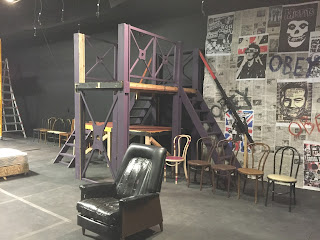 Boy, I lied last time when I said that I would have another post in a couple of days. Here we are, past load in and I am only writing my second post.
Boy, I lied last time when I said that I would have another post in a couple of days. Here we are, past load in and I am only writing my second post.In my last post, I talked about the set concept as it related to our three heroes. This time, I want to talk about the actual set itself and why we've done what we have. American Idiot does have a plot woven through it, but its identity lies in the Green Day score and the punk culture of the early 2000's.
The whole pop aesthetic of that time, already 15 years ago, was driven the emerging saturation of the media. The rise of technology and the Internet in the 90's forced digital media into every nook and cranny of our world. Music videos were already a generation old and MTV had already reinvented itself at the time of our story, replaced by YouTube. The Internet and YouTube allowed anyone who could produce a video to become a star on their own music channel.
 Likewise, the news media pervaded our daily world unlike anytime ever before. When Japan bombed Pearl Harbor in 1941, most Americans didn't find out until the next day. When terrorists hijacked three airliners in 2001, we watched on live TV as the second one impacted the World Trade Center. For days, every channel, every media outlet was a constant stream of live broadcasts from "ground zero". So, where am I going with all of this???
Likewise, the news media pervaded our daily world unlike anytime ever before. When Japan bombed Pearl Harbor in 1941, most Americans didn't find out until the next day. When terrorists hijacked three airliners in 2001, we watched on live TV as the second one impacted the World Trade Center. For days, every channel, every media outlet was a constant stream of live broadcasts from "ground zero". So, where am I going with all of this??? For American Idiot's original designers as for me, that media is the backdrop for our show. Actually, and metaphorically, the media is what saturates our heroes. The original set had TVs all over it as well as video projection that washed the entire stage. The walls of the original stage were plastered with posters from punk bands of the day. We do not have the budget for that kind of video media nor the people to produce it, install it and run in. What we decided to do instead, was to plaster our wall with newspaper, to represent that media saturation. Interspersed are a few band posters, chosen to reflect the cynicism in that music art form.
For American Idiot's original designers as for me, that media is the backdrop for our show. Actually, and metaphorically, the media is what saturates our heroes. The original set had TVs all over it as well as video projection that washed the entire stage. The walls of the original stage were plastered with posters from punk bands of the day. We do not have the budget for that kind of video media nor the people to produce it, install it and run in. What we decided to do instead, was to plaster our wall with newspaper, to represent that media saturation. Interspersed are a few band posters, chosen to reflect the cynicism in that music art form.  Executing this posed a problem in our little black box. Building walls 12' high and 50' long was cost prohibitive, but in the solution, I think that I added yet another layer to the metaphor. To solve it, I chose to use a 9'x12' canvas drop cloth and a 15'x12' canvas drop cloth as my base and wallpaper them with newspaper and band posters. These hang on the back wall, bubbling, peeling and lifting. They are NOT concrete, just like the world that they represent. They are imperfect, fluid, and fragile...just like our heroes.
Executing this posed a problem in our little black box. Building walls 12' high and 50' long was cost prohibitive, but in the solution, I think that I added yet another layer to the metaphor. To solve it, I chose to use a 9'x12' canvas drop cloth and a 15'x12' canvas drop cloth as my base and wallpaper them with newspaper and band posters. These hang on the back wall, bubbling, peeling and lifting. They are NOT concrete, just like the world that they represent. They are imperfect, fluid, and fragile...just like our heroes.

In the original staging, the centerpiece of the set was a multi-story steel fire escape, which served as multiple levels for the roof of the Seven-11, the fire escape on which Johnny first sees Whats-Her_Name, and a variety of other staging. After discussion, Scott and I felt that we too needed some vertical element on the set to pull off some of these above and below staging requirements. What I did, while a similar function, is distinctly different in its appearance. It is more industrial, more gritty. It can be a building, fire escape, or ruins in war. It is not as one-dimensional in looking like a fire escape as the original design was.

Yesterday was the big load in day. We managed to get the seating risers all rearranged and the chairs on them in stacks...out of the way. We then built our structure and hung the smaller of the two media drops.

On Sunday afternoon, I finished wall papering the large drop, so sometime this week, we can get it installed in the theater.
I'll likely squeeze out one more post after addressing the paint treatment for the floor.
R





